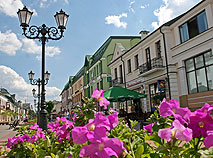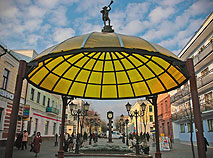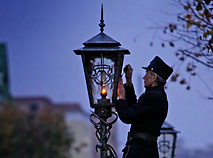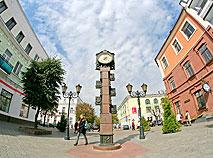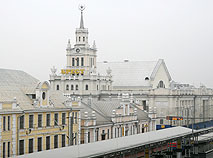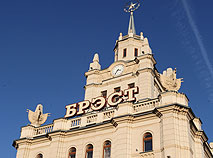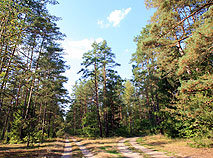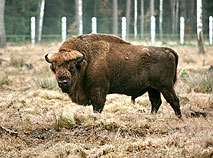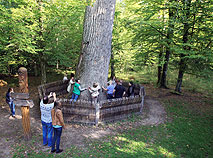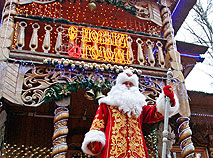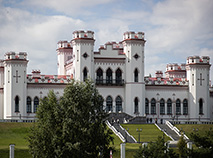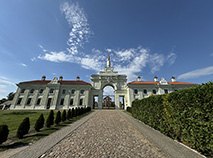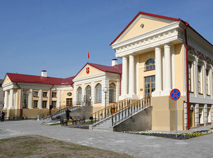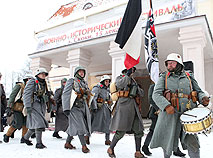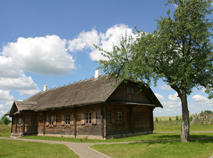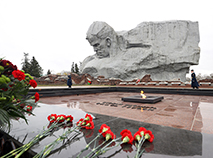Brest Oblast Landmarks
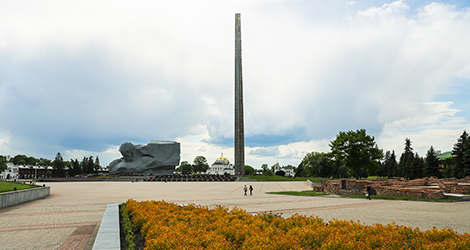
The south-western region of Belarus called "the country’s first bastion" is famous for its unique historical sites and natural monuments. These monuments include the legendary Brest Fortress, the heroic history of which is well known all over the world, the oldest European forest Belovezhskaya Pushcha with majestic aurochs, the points of the Struve Arc that is the largest geodetic instrument on the planet and is included in the UNESCO World Heritage List, the 13th-century wooden town discovered by archaeologists, and the gorgeous palaces in Ruzhany and Kossovo. Brest Oblast gave birth to the national hero of two countries Tadeusz Kosciuszko. The Dostoyevskys' family estate also used to be situated here.
Brest
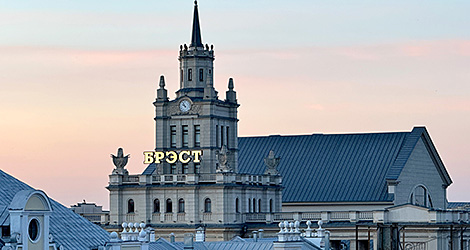
The town of Berestye that stretches along the Bug River was first mentioned in The Tale of Bygone Years in 1019. For centuries Brest, which is called the western gateway to Belarus, has been part of different states, destroyed and rebuilt again. Hence its numerous features: from the ancient settlement of Berestye to the well-kept buildings of the imperial Brest-Litovsk and the Polish Brest-on-the-Bug.
Today the city is a popular tourist destination. The city’s landmarks include the railway station built to the order of Alexander II (it was considered the largest and most beautiful in the Russian Empire); the pedestrian Sovetskaya Street known for old gas street lamps that are lit by a lamplighter every night; Gogol Street where you can meet many characters from the writer’s immortal works; Brest Millennium Monument, a circular high relief depicting historical personalities and generalized images of the city residents under the cover of the guardian angel; Railway Museum which was reopened after renovations on the day of the 999th anniversary of Brest.
Brest Hero Fortress
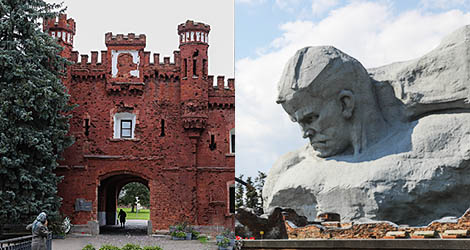
Belarus’ major citadel took the brunt of the fierce Nazi attacks at the very start of the Great Patriotic War. The fortress held off the German offensive for 28 days. A grandiose memorial complex was erected to commemorate the fortress defenders. In the center of the complex is the 33.5-meter high Courage Memorial depicting a warrior and a banner. The unique open-air architectural and sculptural ensemble tells a tragic story of the heroic defense of the fortress. Here you can see a 100-meter high Bayonet Obelisk – the symbol of the victory over the enemy, the Ceremony Square commemorating the fallen heroes, the Brest Fortress Defense Museum and one of the oldest stone buildings of the old Brest-Litovsk – While Palace.
![]() St. Nicolas Church was built on the territory of the fortress in 1851-1876. This magnificent Byzantine-style basilica is one of the most beautiful churches in Central Europe. At the beginning of the war it became a major stronghold of the fortress defenders.
St. Nicolas Church was built on the territory of the fortress in 1851-1876. This magnificent Byzantine-style basilica is one of the most beautiful churches in Central Europe. At the beginning of the war it became a major stronghold of the fortress defenders.
![]() Brest Hero Fortress Memorial Complex, Brest
Brest Hero Fortress Memorial Complex, Brest![]() Open from 9:00 to 18:00, Monday off. Excursions around the complex are available every day.
Open from 9:00 to 18:00, Monday off. Excursions around the complex are available every day.
Berestye Archaeological Museum
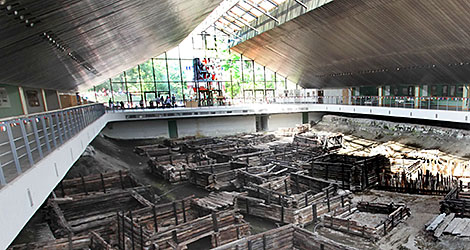
Europe’s only museum of a Medieval Eastern European town is located on the territory of the Brest Fortress where the ancient town of Berestye had been founded many centuries before the fortress was erected. In 1968 scientists discovered here an artisans’ neighborhood four meters underground. This neighborhood consisted of dozens of wooden buildings dating back to the 11th-13th centuries, pavements and wooden fences, remnants of clay furnaces. A pavilion was set up at the place where the ancient settlement was discovered. Today this unique museum features archaeological finds of the 11th-14th centuries that give a glimpse of the ancient Slavonic town, its arts and trades, and the everyday life of local residents. The museum’s holdings have some truly unique artifacts: an oak plower, a boxwood comb with carved Cyrillic letters on it…
![]() Hospital Island, Brest Fortress
Hospital Island, Brest Fortress![]() Open from 10:00 to 18:00 (March-October; seven days a week); from 10:00 to 17:00 (November-February; Monday, Tuesday off).
Open from 10:00 to 18:00 (March-October; seven days a week); from 10:00 to 17:00 (November-February; Monday, Tuesday off).
Brest Railway Station
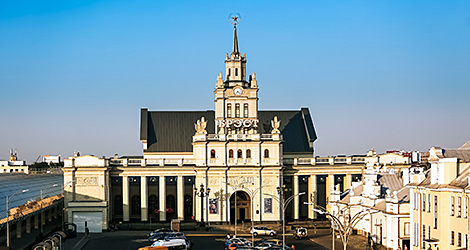
The first railway station in Brest opened in 1886. Soon after the building was inaugurated – on 29 August – Emperor Alexander III and his son Nicholas welcomed heir to the German throne Prince Wilhelm there. An impressive building with majestic arcs and spikes resembled a fortress built on an island. The railway station in Brest was by right considered the most sophisticated and convenient railway station in the Russian Empire and was the first one to start using electric lighting in 1888. The Soviet-style renovations added a broach spire and a five-point star on top of the building, which became a real landmark of the town.
![]() In June 1941 the staff of the railway station defended the building of the station for nine days hiding in labyrinth-like basements just like the Brest Fortress soldiers.
In June 1941 the staff of the railway station defended the building of the station for nine days hiding in labyrinth-like basements just like the Brest Fortress soldiers.
![]() 1 Privokzalnaya Square, Brest
1 Privokzalnaya Square, Brest
Niemcewicz estate in Skoki village
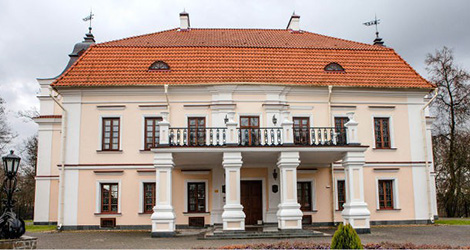
The magnificent Baroque-style estate was built in the 1770s to the order of Marceli Niemcewicz, a representative of the old family. The estate was inherited by his son Julian Niemcewicz, a writer, historian, and public figure, who served as an aide-de-camp to Tadeusz Kosciuszko and participated in the drafting of the first European constitution. The famous estate was visited by Russia Emperor Alexander III, Tadeusz Kosciuszko, artist Napoleon Orda, and poet Adam Mickiewicz. During the First World War the estate was used as the headquarters of the commander of the German Eastern Front Prince Leopold of Bavaria…The halls, music and art lounge, and arms room of the Niemcewicz estate history museum have undergone large-scale renovations.
The estate of the Niemcewicz family played a key role in the history: a truce was singed there on 15 December 1917. Two days later the estate hosted the first meeting on the peace negotiations. The Treaty of Brest-Litovsk was signed at the White Palace of the Brest Fortress on 3 March 1918.
![]() Today the Niemcewicz estate offers guided tours, organizes balls and literary evenings. In December it hosts the international military history festival Skoki re-enacting the events of the First World War.
Today the Niemcewicz estate offers guided tours, organizes balls and literary evenings. In December it hosts the international military history festival Skoki re-enacting the events of the First World War.
![]() 50 Mira Street, village of Skoki, Brest District
50 Mira Street, village of Skoki, Brest District
![]() Open daily from 11.00 to 19.00 but for Monday and Tuesday.
Open daily from 11.00 to 19.00 but for Monday and Tuesday.
Belovezhskaya Pushcha
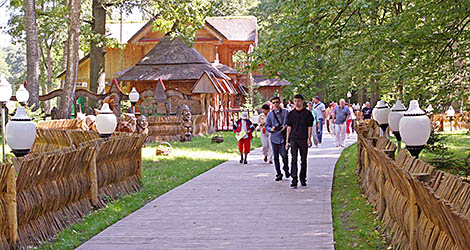
The legendary Belovezhskaya Pushcha is one of the oldest reserves in the world, the largest part of the vast surviving old-growth forest of Europe which many centuries ago stretched from the Baltic Sea to the Bug River and from the Oder River to the Dnieper River. The unique natural area that covers Belarus and Poland is on the UNESCO World Heritage List. In addition, Belovezhskaya Pushcha is the largest of the four national parks of Belarus (the area is nearly 153,000ha). In 1993, it was awarded the status of a biosphere reserve. In 1997 it received the Council of Europe’s European Diploma of Protected Areas for special merits in the conservation of biological, geological and landscape diversity.
![]() In 2009, Belarus celebrated the 600th anniversary of the nature protection regime in Belovezhskaya Pushcha. The wildlife in the Pushcha is unique in terms of biodiversity and the number of rare species of flora and fauna. Among them is the bison, the country's symbol, the heaviest and largest mammal in Europe, the last European representative of wild bulls.
In 2009, Belarus celebrated the 600th anniversary of the nature protection regime in Belovezhskaya Pushcha. The wildlife in the Pushcha is unique in terms of biodiversity and the number of rare species of flora and fauna. Among them is the bison, the country's symbol, the heaviest and largest mammal in Europe, the last European representative of wild bulls.
![]() Village of Kamenyuki, Kamenets District, Brest Oblast
Village of Kamenyuki, Kamenets District, Brest Oblast
Belovezhskaya Pushcha Bisons
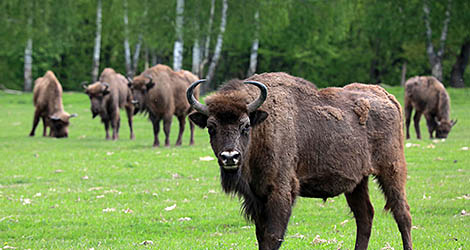
The main asset of the famous forest is the world’s second largest population of bisons of the Belovezhskaya line. Back in 1926, there were only 52 European bisons. Only six of them were used to save the species from extinction. Today Belarus can boast the second largest population: about 1,200 out of 4,500 in the world. Nine micro-populations live in Belarusian forests: the biggest one lives in Belovezhskaya Pushcha (460), others live in Borisov-Berezina, Ozerany, Naydyany, Lyaskovichi, Osipovichi, Polesie, Naliboki and Ozersk. Within the framework of the Russian-Belarusian Union State program "Roadmap for Bisons" for 2014-2018 the work is underway to create a bison nursery in Belovezhskaya Pushcha.
![]() The bison was the mascot of the 2014 IIHF Ice Hockey World Championship in Minsk.
The bison was the mascot of the 2014 IIHF Ice Hockey World Championship in Minsk.
Father Frost’s Residence
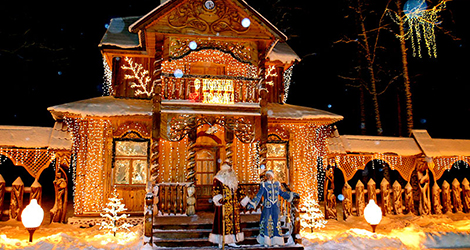
The oldest reserve forest has another landmark - the residence of the Belarusian Father Frost. Wooden houses decorated with fretwork and sculptures of fairytale characters, and, of course, fairytale characters themselves who welcome visitors - all this creates the atmosphere of the New Year's miracle. Here you can help Snow Maiden to shake up Father Frost’s pillows, visit the Magic Mill that turns bad deeds into dust, learn the secrets of making snowflakes in the workshop of Mother Winter, visit the Museum of Ice Life and take part in the dances around the tallest live Christmas tree in the world, which is 150 years old.
![]() Father Frost’s Residence in Belovezhskaya Pushcha is open all year round.
Father Frost’s Residence in Belovezhskaya Pushcha is open all year round.
![]() Belovezhskaya Pushcha, Brest Oblast
Belovezhskaya Pushcha, Brest Oblast![]() 9:00-18:00
9:00-18:00
Kamenets Tower
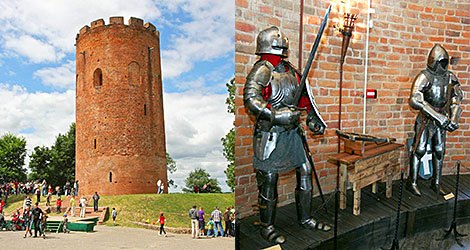
The 700-year-old donjon tower, which is often called the White Tower, is a remarkable architectural symbol of Belarus. The 30-meter tower with strong walls, narrow arrow slits and a crenellation on the top was built in the second half of the 13th century upon the order of Prince Vladimir Vasilkovich to reinforce the borders of the Principality of Galicia-Volhynia. Throughout its history, the tower has withstood numerous sieges by crusaders and Tatars. It has been the battleground for the neighboring armies. At present it is the only surviving building of the kind in Belarus. Kamenets Tower (vezha in Belarusian) is located several kilometers away from Belovezhskaya Pushcha National Park. However, the famous forest does not take its name from the name of this red-brick tower.
At the foot of the tower there is a bronze monument depicting the founder of the town of Kamenets Prince Vladimir Vasilkovich and a bison which is a symbol of the region.
![]() Town of Kamenets, Brest Oblast
Town of Kamenets, Brest Oblast
![]() 10:00 – 18:00. Closed on Monday and Tuesday
10:00 – 18:00. Closed on Monday and Tuesday
Struve Geodetic Arc
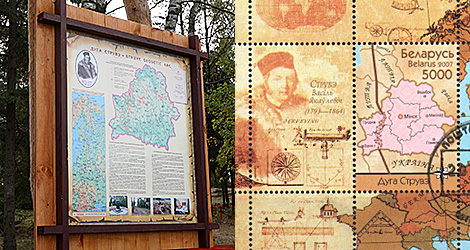
The Struve Geodetic Arc is a unique monument of history and a scientific masterpiece of the 19th century. It was named after astronomer and mathematician, first director of the Pulkovo Astronomical Observatory Vasily Struve (Friedrich Georg Wilhelm von Struve). It took almost 40 years to build the longest (2,820km) and the most precise geodetic instrument in the world consisting of 265 triangulation points in ten European countries. The majority of the Struve Geodetic Arc’s points (19) are located in Belarus (historians say that there were 31 stone cubes on the territory of the country), five of them are included in the UNESCO World Heritage List. Leskovichi, Osovnitsa and Chekutsk points are located in Brest Oblast, Lopaty and Tupishki points are in Grodno Oblast.
![]() Brest Oblast and Grodno Oblast
Brest Oblast and Grodno Oblast
Ruzhany Castle
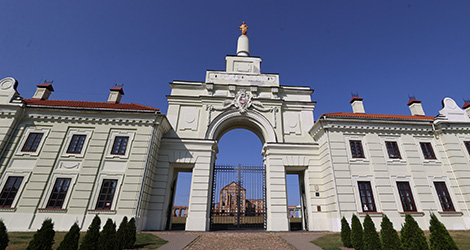
The ancient residence of the powerful Sapiehas dynasty is famous for its romantic atmosphere. In the 1770s Prince Alexander asked Saxon architect Jan Samuel Becker to turn the impregnable castle into an elegant palace with gardens, parks and greenhouses. The pride of Ruzhany Castle was its big library and one of the best theaters in Europe. The castle has survived numerous wars, and is currently being renovated. Tourists can see the renovated central gate (brama) and castle wings, enjoy the exposition in the museum of the Sapiehas’ Castle Complex featuring original utensils and interior elements which decorated the rooms of the renowned castle owners.
![]() Every year the castle complex hosts the historical festival Ruzhanskaya Brama.
Every year the castle complex hosts the historical festival Ruzhanskaya Brama.
![]() Town of Ruzhany, Pruzhany District, Brest Oblast
Town of Ruzhany, Pruzhany District, Brest Oblast
Pruzhanski Palatsyk Museum Estate
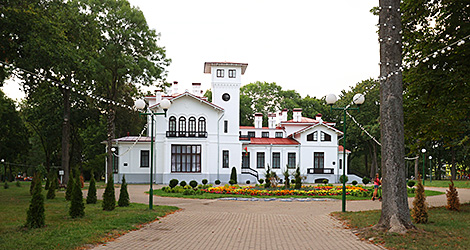
The small palace with unusual asymmetric architecture in the town of Pruzhany is the only renovated modernist style estate in Belarus. The magnificent residence was constructed thanks to the owners of the estate Walenty and Herminja Szwykowskis in the middle of the 19th century. The palace compound featured buildings of different sizes but with one architectural style with a tower in the center of the facade, windows (from small and narrow to large Venetian ones), balconies, and a magnificent terrace. The estate was surrounded by a park, and there was an exotic greenhouse nearby. Today the visitors to the museum estate Pruzhanski Palatsyk (small palace of Pruzhany) can see the interior decorations of a 19th-century house of the Polish nobility: a saloon, a flower hall, a hunter’s room…
![]() The museum estate frequently houses exhibitions, presentations, and soirees.
The museum estate frequently houses exhibitions, presentations, and soirees.
![]() Pruzhany, Brest Oblast
Pruzhany, Brest Oblast
![]() Open daily from 10:00 to 18:00, closed on Monday and Tuesday.
Open daily from 10:00 to 18:00, closed on Monday and Tuesday.
Palace of the Puslowskis in Kossovo
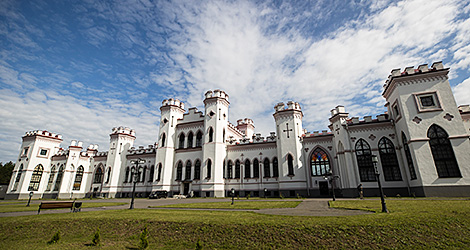
The Kossovo Castle has been dubbed “knights’ dream” for its fairytale-like appearance and splendor. For several centuries it was owned by distinguished dynasties: the Khreptovichs, Sanguszkos, Flemmings, Czartoryskis, and Sapiehas. The golden age of the estate coincided with the years when it was owned by the wealthy industrialist Count Wandalin Puslowski, who was the first in Belarus to use a steam engine. The Kossovo Palace became popular due to its luxurious halls and a magnificent park with over 150 species of exotic plants. The palace boasted over 100 rooms. The Ceremonial Chamber was probably the most amazing one. They say that its floor was made of glass with a fish aquarium underneath.
![]() Another legend says that there used to be a 25-kilometer tunnel that connected the Kossovo Palace with the residence of the Sapieha family in Ruzhany. It is believed that a carriage with horses could pass through that tunnel.
Another legend says that there used to be a 25-kilometer tunnel that connected the Kossovo Palace with the residence of the Sapieha family in Ruzhany. It is believed that a carriage with horses could pass through that tunnel.
![]() Town of Kossovo, Ivatsevichi District, Brest Oblast
Town of Kossovo, Ivatsevichi District, Brest Oblast
Tadeusz Kosciuszko Museum Estate
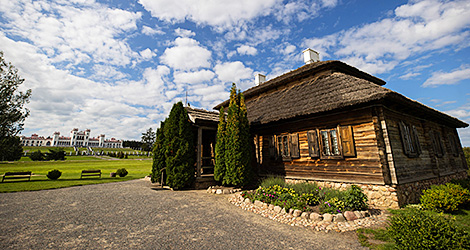
The birthplace of Tadeusz Kosciuszko, a national hero of Poland and the USA, an honorary citizen of France, is located not far from the town of Kossovo in the area of Merechevshchina. The estate survived thanks to the efforts of the Counts Puslowskis, who restored it and founded a museum of the famous fellow countryman in 1857. During the Great Patriotic War the house burnt to the ground and has recently been restored on the old foundation. Today visitors can see the interior dating back to the age when Tadeusz Kosciuszko was alive as well as household items, clothes and arms — sabers, models of pistols, cannon balls and bullets, a copy of the coat that the hero used to wear…
![]() Merechevshchina, Kossovo, Ivatsevichi District, Brest Oblast
Merechevshchina, Kossovo, Ivatsevichi District, Brest Oblast
Museum Estate Zaosye
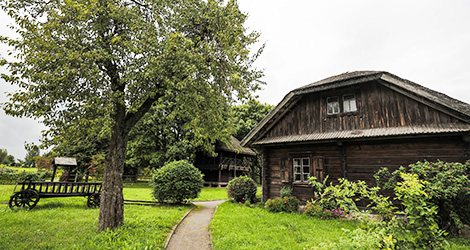
The house-museum in Novogrudok is not the only memorial place in Belarus associated with the life of Adam Mickiewicz. The poet was born in his family-owned manor house Zaosye on the Christmas Eve of 1798. Two centuries later the house was turned into a museum. The house of the 18th-19th centuries was re-created on the old foundations according to the drawings by Napoleon Orda, who was friends with Adam Mickiewicz, and Eduard Pavlovich, a teacher of the Novogrudok gymnasium. In the center there is the house with a reed roof surrounded by a flower garden, a pond with a banya (sauna), a two-storey barn with a summer room of the young poet and agricultural buildings. The centerpiece of the exposition is the famous poem Pan Tadeusz (Sir Thaddeus).Thanks to the descriptions from the poem and the rare exhibits, the visitors to the museum can imagine the way the noble families lived several centuries ago. The exposition tells about the childhood and the youth in Zaosye and Novogrudok, first love and first poetic lines, which we learn in school, legends and traditions, the beauty of the nature – all this Adam Mickiewicz celebrated masterfully and subtly in his works.
![]() Zaosye village, Baranovichy District, Brest Oblast
Zaosye village, Baranovichy District, Brest Oblast
![]() Working hours: 10.00-17.00, closed on Monday, Tuesday
Working hours: 10.00-17.00, closed on Monday, Tuesday
Holy Trinity Catholic Church in Ishkold
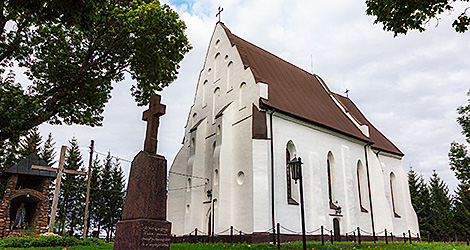
The Holy Trinity Catholic Church in Ishkold is one of Belarus’ oldest temples that has never been seriously destroyed or remodeled. The legend says that it was founded by the owner of the estate Nikolai Nemirovich in 1449 as gratitude to the god for his long-awaited son. Built in the style of late Gothic, the temple only remotely resembles European and Belarusian Gothic-style churches. Unlike the famous temples of Gervyaty and Vidzy, the church in Ishkold is a specimen of pure Belarusian Gothic style that combines features of religious and defense buildings. It is the only Belarusian Catholic church that has preserved Gothic ribbed vaults inside.
![]() Village of Ishkold, Baranovichi District, Brest Oblast
Village of Ishkold, Baranovichi District, Brest Oblast
Suvorov Museum in Kobrin
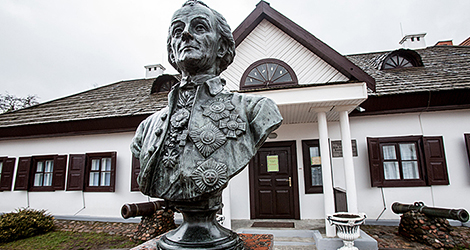
The old manor house in the center of Kobrin has been bearing the name of Suvorov's House for several centuries already. The estate Kobrinsky Klyuch near Brest was granted to prominent Russian general Alexander Suvorov, who never lost a battle and was undefeated in over 60 large battles, by Russian Empress Catherine II in 1795. The renowned general lived in the estate from 1797 till 1800. He liked to stroll along the alleys of the park and swim in the local pond. He attended services at Sts Peter and Paul Church and even was part of the church choir. The Suvorov War History Museum of Kobrin was set up in Suvorov's former estate in 1946. The unique holdings of the museum comprise 20 collections featuring over 50,000 exhibits. The museum tells about Alexander Suvorov’s life and the war history of the country in general. It showcases ancient weapons, military uniforms of different periods of history, and works of art… The entrance to the museum is decorated with a bronze bust of Alexander Suvorov by sculptor P. Kyuferle.
The park of Kobrin, the oldest and one of the most beautiful parks in Belarus, is also named after Alexander Suvorov. It was created in 1768 by order of the Grand Duchy's crown treasurer Antoni Tyzenhaus. A stone with an inscription reading “Suvorov liked to rest on this stone” still can be found near the pond where the 67-year-old general used to swim on cold April days.
![]() 14 Suvorova Street, Kobrin, Brest Oblast
14 Suvorova Street, Kobrin, Brest Oblast
Fyodor Dostoyevsky Museum, the family estate of the Dostoyevskys
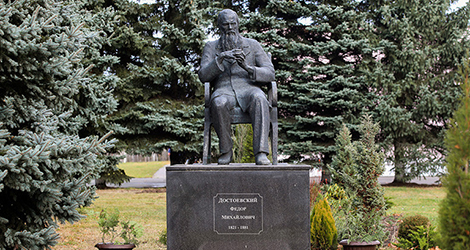
The history of the family that gave birth to the 19th century’s greatest writer — Fyodor Dostoyevsky — began in Belarusian Polesie. In 1506 the Prince of Pinsk gave the local lands to the nobleman Danila Rtishchev, who built an estate in the village of Dostoyevo between the rivers Pina and Yaselda. The landowner’s first son had a double surname of Rtishchev-Dostoyevsky while the generations after him became Dostoyevskys. Centuries later the family moved to Volyn and then to Moscow where the future writer was born. In 2012 scientists found original residential buildings of the 16th-18th centuries, remnants of stoves, silverware, ceramics, bullets, and fragments of the family coat of arms of the Dostoyevskys in Dostoyevo. The family estate is being restored now.
![]() There is a museum of Fyodor Dostoyevsky in Dostoyevo. It boasts over 3,000 exhibits, including a diorama of the estate, the family tree of the Dostoyevskys, photo copies of unique documents about the life and work of the writer, books in various languages. The Dostoyevsky Museum in Polesie is part of the tour Yanovskoye Koltso.
There is a museum of Fyodor Dostoyevsky in Dostoyevo. It boasts over 3,000 exhibits, including a diorama of the estate, the family tree of the Dostoyevskys, photo copies of unique documents about the life and work of the writer, books in various languages. The Dostoyevsky Museum in Polesie is part of the tour Yanovskoye Koltso.
![]() Village of Dostoyevo, Ivanovo District, Brest
Village of Dostoyevo, Ivanovo District, Brest
Napoleon Orda Museum in Vorotsevichi
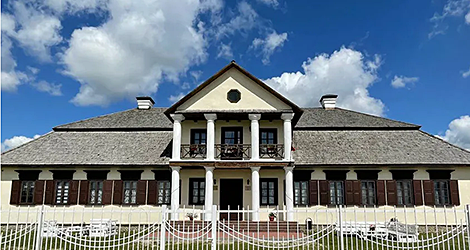
Napoleon Orda was a unique personality in the history of the Belarusian and European culture. He was a prominent musician, composer, teacher, scientist, and, above all, an outstanding artist specializing in sketches of architectural sites, urban and rural landscapes, and birthplaces of famous people such as Tadeusz Kosciuszko, Adam Mickiewicz, Stanislaw Moniuszko… In 1840-1880 he made over 1,150 detailed watercolor paintings and graphics of landmarks of Belarus, Ukraine, Lithuania, Poland, France, Germany, Spain, and Portugal. Napoleon Orda’s paintings depicted old castles and palaces in fine detail. Today restorers from different parts of Europe use his drawings and paintings to reconstruct the lost historical monuments and restore them back to the original splendor. Napoleon Orda traveled around Belarus and made around 200 sketches of towns and villages, old estates and castles – in Mir, Nesvizh, Ruzhany, Kossovo, Grodno, Novogrudok, Lida, Krevo…
A museum with an exhibition hall and a picture gallery was created in Napoleon Orda’s native village of Vorotsevichi. The artist’s family estate in Krasny Dvor area is currently under renovation. The project also envisages the construction of a country estate, small crafts workshops, a stable yard, a park, a pond, a cafe, and a hotel.
![]() Village of Vorotsevichi, Ivanovo District, Brest Oblast.
Village of Vorotsevichi, Ivanovo District, Brest Oblast.
![]() The museum is open from 9 a.m. till 6 p.m. on Monday-Friday, and from 9 a.m. till 1 p.m. on Saturday and Sunday.
The museum is open from 9 a.m. till 6 p.m. on Monday-Friday, and from 9 a.m. till 1 p.m. on Saturday and Sunday.


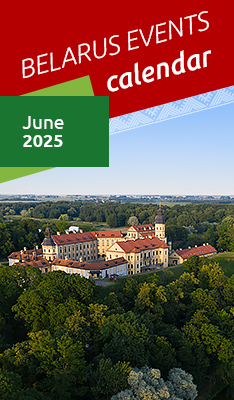




 print version
print version make home page
make home page add to bookmarks
add to bookmarks